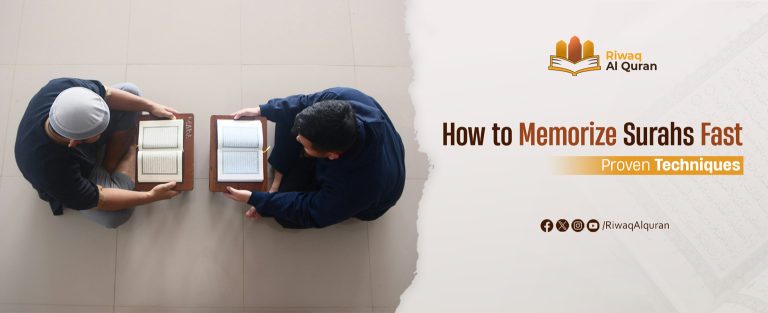The Quran is filled with various signs and symbols that guide its recitation and enhance understanding. These include the mysterious Huroof Muqatta’at—disjointed letters appearing at the start of some Surahs, the 15 prostrations (Sajdahs) of humility, and Madd symbols that elongate specific sounds during recitation.
Since the Quran is the revelation from Allah and a complete code of life, Riwaq Al Quran, dedicated to the teachings of the Quran, delves into the significance of the signs that can be found in it and their impact on understanding the divine scripture. Let’s start!
Table of Contents
What Are the Signs and Symbols in the Quran?
In the Quran, some tajweed signs and symbols are used to provide guidance on how to recite the text correctly, indicating pauses, continuations, and specific actions to be performed during recitation. These symbols help maintain the intended meaning and proper practice of reading the Quran.
How Many Huroof Muqattaat in the Quran?
The Huroof Muqatta’at are the disjointed letters that appear at the beginning of some Surahs in the Quran. There are 29 instances of Huroof Muqatta’at in the Quran. These letters are considered to be among the mysteries of the Quran, the precise meaning of which is known only to Allah. For example:
- Alif Lam Mim (الم): Al-Baqarah, Al ‘Imran, Al-Ankabut, Ar-Rum, Luqman, As-Sajda
- Alif Lam Mim Ra (المر): Al-A’raf
- Alif Lam Ra (الر): Yunus, Hud, Yusuf, Ibrahim, Al-Hijr
- Alif Lam Mim Ra (المر): Ar-Ra’d
- Kaf Ha Ya Ain Sad (كهيعص): Maryam
- Ta Ha (طه): Ta-Ha
- Ta Sin Mim (طسم): Ash-Shu’ara, Al-Qasas
- Ta Sin (طس): An-Naml
- Ya Sin (يس): Ya-Sin
- Sad (ص): Sad
- Ha Mim (حم): Ghafir, Fussilat, Az-Zukhruf, Ad-Dukhan, Al-Jathiyah, Al-Ahqaf
- Ha Mim Ain Sin Qaf (حم عسق): Ash-Shura
- Qaf (ق): Qaf
- Nun (ن): Al-Qalam


How Many Rukus in Quran?
In the Quran, there are no “Rukus,” but there are “Sajdahs,” which are moments where believers are called to prostrate in reverence to Allah. These Sajdahs are an act of submission and humility, performed in acknowledgment of Allah’s greatness.
Engaging in these acts of prostration while reciting specific verses of the Quran helps deepen one’s spiritual connection and mindfulness during worship. Check the next title to discover how many such moments are present in the Quran!

How Many Sajdah are in the Quran?
There is a difference of opinion among scholars regarding the number of Sajdas in the Quran, and their evidences are detailed in the jurisprudence books of each Islamic school of thought. However, they agree that the total number of Sajdahs is 15.
However, their disagreement on the number of Sajdahs is as follows:
- The Hanbali school: 15 Sajdahs.
- The Shafi’i school: 14 Sajdahs, excluding the Sajdah in Surah Sad.
- The Maliki school: 11 Sajdahs, excluding the Sajdahs in the Mufassal.
- The Hanafi school: 14 Sajdahs, excluding the second Sajdah in Surah Al-Hajj.
According to many scholars, the prostration upon reciting these verses is a recommended act of worship but not obligatory. For example:
1. Surah Sad:
“He said, ‘My Lord, forgive me and grant me a kingdom such as will not belong to anyone after me. Indeed, You are the Bestower.'” (38:24)
2. Surah Al-Inshiqaq:
“So remind, if the reminder should benefit; he who fears [ Allah ] will be reminded. But the wretched one will avoid it,” (84:21-22)
3. Surah Fussilat:
“But if they are arrogant – then those who are near your Lord exalt Him by night and by day, and they do not become weary.” (41:38)
4. Surah An-Najm:
“So prostrate to Allah and worship [Him].” (53:62)
How Many Madd in the Quran?
In the science of Tajweed, which governs the correct pronunciation and recitation of the Quran, Madd refers to the stretching of specific sounds to ensure proper articulation and adherence to the rules of recitation.
The concept of Madd is fundamental, as it helps in maintaining the rhythm and flow of the Quranic verses, preserving both their meaning and beauty. Madd is divided into two main types: Original Madd and Secondary Madd. Each type has distinct rules and purposes that dictate when and how much to elongate a letter during recitation:
1. Original Madd (Madd Asli)
This is the natural elongation, which does not require any specific cause. It is extended for the duration of two counts only, neither more nor less. Examples include the elongation of the “Alif” in “قال” (Qala), the “Ya” in “قيل” (Qil), and the “Waw” in “يقول” (Yaqul), and similar cases.
2. Secondary Madd (Madd Far’i)
This type of Madd requires a cause, such as the presence of a Hamzah (glottal stop) or a Sukoon (resting state of the letter). According to its rule, it is further divided into three subtypes: necessary (Lazim), obligatory (Wajib), and permissible (Jaiz).
How Many Waqf in the Quran?
In Quranic recitation, certain signs indicate where the reader should pause or continue to ensure correct pronunciation and understanding. These Waqf signs help guide the reader through the text. Here is an explanation of the main pause signs:
- م: A mandatory pause, meaning the reader must stop at this point (Waqf Lazim).
- لا: A prohibited pause, where stopping is not allowed (Waqf Mamnu’).
- ج: A permissible pause, where it is optional for the reader to stop or continue.
- صلى: It suggests that it is preferable to continue reciting wit.
These signs are crucial for maintaining the rhythm and meaning of the Quranic text during recitation.

Importance of Quranic Signs and Symbols
Quranic recitation signs are vital tools that ensure the Quran is read and understood as intended. These signs guide the reader in pronunciation, maintaining the text’s meaning and clarity. Here are some advantages of learning them:
1. Ensuring Correct Pronunciation
Quranic recitation signs, such as Harakat and Tashkeel, provide essential guidance for correct pronunciation. They help readers articulate each word with the intended sounds, avoiding mispronunciations that could alter meanings.
2. Preserving Meaning
The precise pronunciation guided by these signs is crucial for preserving the meaning of the Quranic text. Incorrect recitation can lead to misunderstandings or misinterpretations of verses, which is why these signs play a critical role in maintaining the text’s integrity.
3. Facilitating Recitation
For learners and non-native speakers, recitation signs simplify the process of learning and reciting the Quran. They provide a clear framework for reading and practicing, which is especially important for those who are not familiar with the rules of Arabic grammar and phonetics.
4. Supporting Tajweed Rules
Recitation signs also help in applying tajweed rules, which are the rules governing the pronunciation of the Quranic text. These rules include the correct way to elongate, emphasize, and pause, ensuring the recitation aligns with traditional practices.
5. Enhancing Memorization
Accurate pronunciation aided by Quranic signs supports the memorization of the Quran. When reciters read with the correct pronunciation, it reinforces their ability to memorize and recall verses accurately.
6. Standardizing Recitation
The use of standardized recitation signs helps maintain consistency across different regions and communities. It ensures that the Quran is recited uniformly, preserving the textual and phonetic integrity of the sacred text.
7. Avoiding Errors in Recitation
Recitation signs play a crucial role in preventing errors in recitation. They guide the reader in differentiating between similar-sounding words and phrases, thus minimizing the risk of misrecitation and ensuring that the Quran is read as intended.
8. Enhancing Comprehension
Proper use of recitation signs aids in better understanding the Quranic text. By guiding the reader through correct pronunciation and pauses, these signs help convey the intended meanings and emotions of the verses, enhancing overall comprehension.


Discover Quranic Signs and Symbols with Riwaq Al Quran!
Discover the profound significance of the Quran’s signs and symbols with Riwaq Al Quran! Our dedicated instructors offer in-depth lessons to help you master the art of recitation and deepen your understanding of these sacred elements. Elevate your Quranic journey—sign up for our courses today and embark on a path of spiritual enrichment and learning!
We offer several courses such as:
- Online courses for kids.
- Online Quran classes for kids and adults.
- Online Arabic courses
- Online Ijazah courses
- Online Islamic Studies courses.
Here are a sample of our set of Quran Courses that will be helpful for you:
- Online Tafseer Course: Delve into Quranic meanings with our insightful online Tafseer course.
- Noorani Qaida Online: Learn Quranic basics efficiently through our Noorani Qaida online program.
- Online Quran Recitation Course: Enhance Quranic recitation skills through our expert-led online course.
- Online Tajweed Classes: Master Tajweed rules for beautiful Quranic recitation in online classes.
- Quran Memorization Online Course: Memorize the Quran effectively with our specialized online memorization course.
- Online Qirat Course: Explore diverse Qirat styles with our comprehensive online Qirat course.
- Online Quran Classes for Kids: Nurture a love for the Quran in kids through interactive online classes.
Conclusion
The Quran is rich with signs and symbols that enhance the practice of its recitation and deepen the understanding of its verses. From the Huroof Muqatta’at, which intrigue scholars and believers alike with their mysterious nature, to the Sajdahs that punctuate moments of profound humility and reverence, these elements collectively contribute to the unique and sacred experience of engaging with the Quran.
Understanding these signs and symbols helps readers and reciters maintain the correct rhythm, pronunciation, and spiritual connection during their engagement with the Quran.































